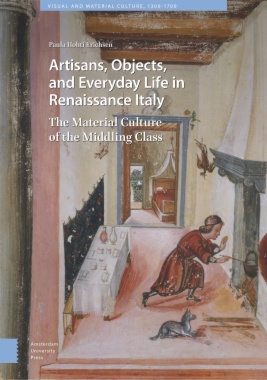Did ordinary Italians have a ‘Renaissance’? This book presents the first in-depth exploration of how artisans and small local traders experienced the material and cultural Renaissance. Drawing on a rich blend of sixteenth-century visual and archival evidence, it examines how individuals and families at artisanal levels (such as shoemakers, barbers, bakers and innkeepers) lived and worked, managed their household economies and consumption, socialised in their homes, and engaged with the arts and the markets for luxury goods. It demonstrates that although the economic and social status of local craftsmen and traders was relatively low, their material possessions show how these men and women who rarely make it into the history books were fully engaged with contemporary culture, cultural customs and the urban way of life.
- Cover
- Title
- Copyright
- Table of Contents
- Acknowledgments
- Notes on Money, Dates and Measures
- List of Illustrations
- List of Tables
- Introduction
- Lower Social Groups and Renaissance Culture
- Artisans and Shopkeepers in Sixteenth-Century Italy
- Renaissance Siena and Its Artisans and Shopkeepers
- The People and Contents of the Book
- Notes
- Part I. Boundaries and Borders: Artisans and Local Traders inRenaissance Society
- 1. Artisans and Local Traders in RenaissanceSiena
- Abstract
- Who Were the Artisans?
- Living and Working in Sixteenth-Century Siena
- Notes
- 2. The Economic Status of Sienese Artisansand Shopkeepers
- Abstract
- Honour, Profit and Power
- Surnames and Identities
- Distribution of Wealth
- Property: Life Styles and Life Stories
- Notes
- 3. Boundaries, Borders, and Hierarchies
- Abstract
- A Hierarchy of Trades
- Moving Boundaries
- Notes
- Part II. Creative Economies: The Acquisition and Circulation of Material Goods
- 4. Business and Income
- Abstract
- Workshop Practice and the Artisan’s World of Work
- Getting Paid
- Wages and Payments
- Supplementary Income
- Notes
- 5. Buying and Acquiring Material Goods
- Abstract
- Buying Goods in Renaissance Siena
- Credit Transactions
- Barter
- Notes
- 6. Dowries and the Circulation of MaterialGoods
- Abstract
- Dowries
- Bridal Trousseau
- Counter-Gifts for the Bride
- The Symbolic and Material Meaning of Wedding Gifts
- Notes
- Part III. The Ownership, Display, and Meanings of Material Goods
- 7. A Respectable and Comfortable Home
- Abstract
- The Size and Organization of Domestic Space
- Furniture for Sleeping
- Chests and Furniture for Storage
- Dining and Preparation of Meals
- Notes
- 8. Novelty, Refinement, and ‘Splendour’
- Abstract
- Ornamental Furnishings
- Tableware
- Credenzas
- Paintings, Sculpture, and Books
- Books and studioli
- Notes
- 9. The Home on Show
- Abstract
- The House as a Social Space
- Household Goods and Identity
- Notes
- Conclusion
- Appendix
- The house of the shoemaker Girolamo di Domenico
- The house of the silk weaver Giovanni di Agniolino
- The house of the tailor Pietro di Ser Giovanni
- The house of the innkeeper Marchione di Paulo from Mulazzo
- The house of the baker Pietro from Voltolina
- The house of the second-hand dealer Vincenzo di Matteo
- The house of the barber Cesario di Albertino
- The house of the professional fife player Luzio di Paulo
- The house of the master woodcarver Cristofano di Bartolomeo
- Glossary
- Bibliography
- Primary Sources
- Secondary Sources
- About the Author
- Index
- Back Cover

